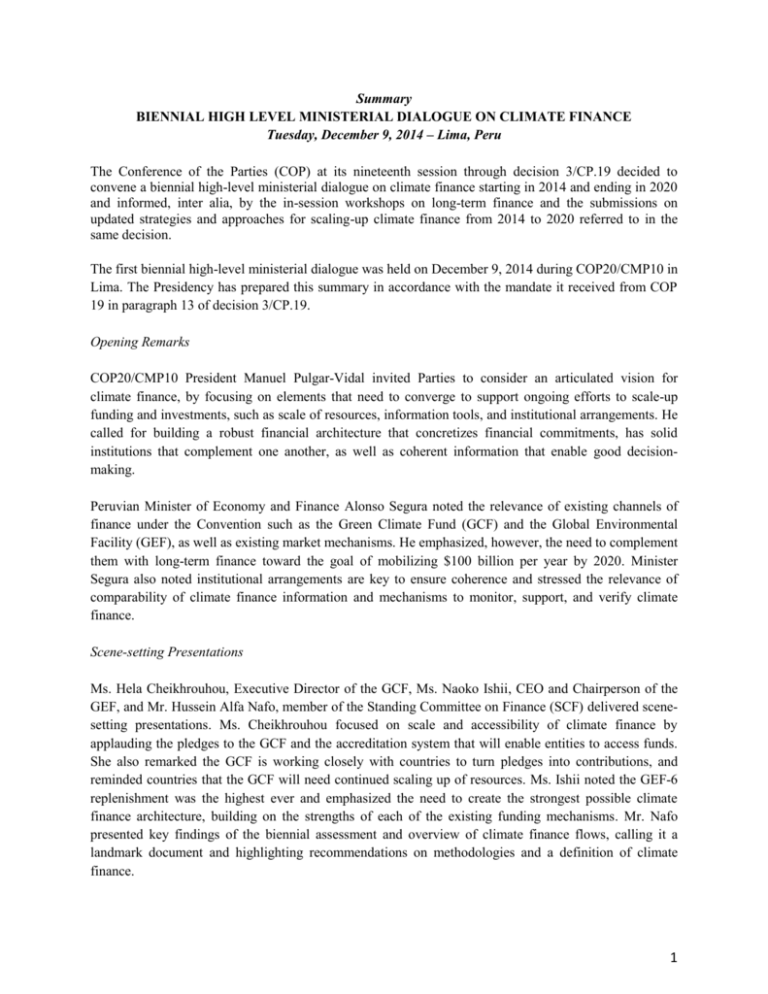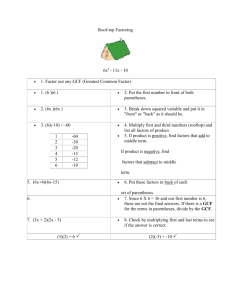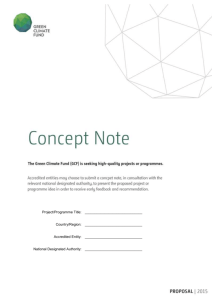Summary BIENNIAL HIGH LEVEL MINISTERIAL DIALOGUE ON
advertisement

Summary BIENNIAL HIGH LEVEL MINISTERIAL DIALOGUE ON CLIMATE FINANCE Tuesday, December 9, 2014 – Lima, Peru The Conference of the Parties (COP) at its nineteenth session through decision 3/CP.19 decided to convene a biennial high-level ministerial dialogue on climate finance starting in 2014 and ending in 2020 and informed, inter alia, by the in-session workshops on long-term finance and the submissions on updated strategies and approaches for scaling-up climate finance from 2014 to 2020 referred to in the same decision. The first biennial high-level ministerial dialogue was held on December 9, 2014 during COP20/CMP10 in Lima. The Presidency has prepared this summary in accordance with the mandate it received from COP 19 in paragraph 13 of decision 3/CP.19. Opening Remarks COP20/CMP10 President Manuel Pulgar-Vidal invited Parties to consider an articulated vision for climate finance, by focusing on elements that need to converge to support ongoing efforts to scale-up funding and investments, such as scale of resources, information tools, and institutional arrangements. He called for building a robust financial architecture that concretizes financial commitments, has solid institutions that complement one another, as well as coherent information that enable good decisionmaking. Peruvian Minister of Economy and Finance Alonso Segura noted the relevance of existing channels of finance under the Convention such as the Green Climate Fund (GCF) and the Global Environmental Facility (GEF), as well as existing market mechanisms. He emphasized, however, the need to complement them with long-term finance toward the goal of mobilizing $100 billion per year by 2020. Minister Segura also noted institutional arrangements are key to ensure coherence and stressed the relevance of comparability of climate finance information and mechanisms to monitor, support, and verify climate finance. Scene-setting Presentations Ms. Hela Cheikhrouhou, Executive Director of the GCF, Ms. Naoko Ishii, CEO and Chairperson of the GEF, and Mr. Hussein Alfa Nafo, member of the Standing Committee on Finance (SCF) delivered scenesetting presentations. Ms. Cheikhrouhou focused on scale and accessibility of climate finance by applauding the pledges to the GCF and the accreditation system that will enable entities to access funds. She also remarked the GCF is working closely with countries to turn pledges into contributions, and reminded countries that the GCF will need continued scaling up of resources. Ms. Ishii noted the GEF-6 replenishment was the highest ever and emphasized the need to create the strongest possible climate finance architecture, building on the strengths of each of the existing funding mechanisms. Mr. Nafo presented key findings of the biennial assessment and overview of climate finance flows, calling it a landmark document and highlighting recommendations on methodologies and a definition of climate finance. 1 Mr. Edward Davey, Secretary of State for Energy and Climate Change of the United Kingdom, and Ms. Edna Molewa, Minister of Water and Environmental Affairs of South Africa facilitated the dialogue. Interventions from Ministers demonstrated convergence on a number of key elements to advance ambition on climate finance, with a number of countries announcing new contributions to the Green Climate Fund and the Adaptation Fund, which created a positive atmosphere throughout the dialogue acknowledged by several Parties. Multiple interventions referred to transparency as the essential foundation for effective provision and use of climate finance. Participants shared a wide array of views on how to concretize the shared urge for transparency. These included improving the scale of resources to enhance predictability of flows, coherent and strong institutions to channel and manage those resources, and the necessary information to secure they have been deployed and achieved the intended impact. Several interventions called for ambitious scale, including the importance of scaling-up towards $100 billion goal. In addition to quantitative goals and numeric targets, participants remarked that improving existing instruments and processes, and developing new ones, is critical to provide predictability of flows and ensure the sustainability of climate finance. The need to mobilize resources from a variety of sources, including the private sector, was also highlighted. The following remarks and announcement reflected and echoed discussions on scale: o Germany announced a pledge of $50 million Euros to the Adaptation Fund and noted it has been successful in achieving impact on the ground. Belgium and Australia announced new pledges to the GCF, of $51.6 million Euros and $200 million Australian dollars respectively. Several Parties highlighted a diversity of initiatives they are financially supporting. o Improving quantitative information to enhance predictability was a recurrent request from developing countries, including references to improved and more detailed numeric strategies and approaches submissions, and midterm milestones to improve the adequacy of climate finance. o Reference to new sources of finance was made repeatedly as key to provide predictability of flows, as well as the importance of creating the right market signals and using innovative instruments to attract private sources of finance. o A wide number of interventions stressed the critical role of the GCF in the post-2020 world, welcomed the pledges announced in Lima and throughout the initial resource mobilization process. o The key role of adequate enabling environments in enhancing scale, level, and sustainability of climate flows was also emphasized as key to encourage and support climate investments. o Importance of readiness support for capacity building and strengthening country-ownership as well as accessibility of funds. o South-south cooperation was also presented as an increasingly relevant source of climate finance, including an announcement from China that they would double South-south cooperation from $10 million. Ministers also stressed the crucial bridging role institutional arrangements have in enhancing clarity of climate finance provided and used, by improving complementarity and collaboration among funds and other financial bodies and entities, including the GCF, GEF, and also the Adaptation Fund and the SCF. Parties further highlighted: 2 o o The SCF’s recommendations on operational definitions and methodologies of MRV of climate finance. Clear and streamlined mandates to Convention bodies that avoid duplication and improve efficiency, while identifying gaps that could be filled by these bodies considering their mandate. Ministers reminded the urgency of a coherent information system that streamlines and improves the use of existing financial reporting, assessment, and verification tools that are currently disarticulated. Strong climate finance information was deemed critical to build trust among parties and provide clarity on finance received, used, and projected. Some specific remarks specifically acknowledged: o The need for reporting and verification tools of finance mobilized and received, including common reporting frameworks. o Urgency of a definition of climate finance. o Need for credible, robust, and timely information. o Better identification of developing countries’ needs. o The relevance of the information contained in the BA and its recommendations, as well as the need to incorporate them in further work on transparency, verification, and climate finance information. There were also multiple references to the relevance of enabling environments, viewed as multi-angled concept to attract both public and private finance and structured around needs and strong policy frameworks that support the provision and use of climate finance. The balance of adaptation and mitigation finance was also a constant call from countries, including the critical role of quantitative information to enhance ambitious adaptation action. Multiple interventions acknowledged the key role of the Adaptation Fund in providing direct access and enhancing country ownership. Conclusions Ministers were of the view that the UNFCCC has many of the institutional basis and many of the instruments and elements to provide predictability, accessibility of, and clarity in the use of financial flows. Particularly, the importance that funding is monitored, verified and reported was highlighted. Ministers further noted that many of those instruments need to be improved or enhanced, as well as respond to strategic mandates that are less reactive, and more strategic. Clear signals on the need for improved predictability of climate finance flows, and improved information on climate finance provided and used were required, noting they are essential for progress on enhancing climate finance. There was a strong call for changing and improving how the Convention is dealing with these key issues. The dialogue provided a clear political signal on the need to articulate those elements that enable successful mobilization, deployment, and use of climate finance not only for the pre-2020 period, but also as Parties approach the post-2020 world, and ultimately securing much needed predictability, efficiency and clarity in the flow of resources. 3








